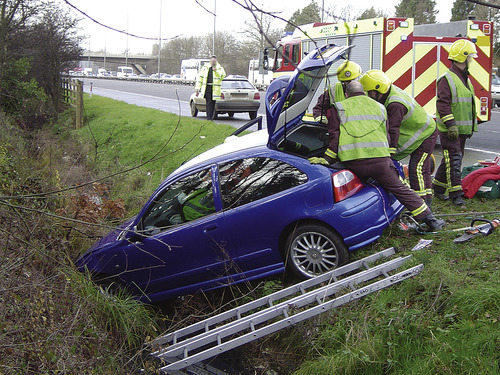CASE 13
 |
Incident
A 45-year-old male has been involved in a single vehicle accident. The tasking agency reports that the patient is ‘unconscious’.
Relevant information
▪ Aircraft: Rotary wing
▪ Ground resources: One land ambulance. Police and Fire & Rescue Services
▪ Retrieval options: General hospital 5 minutes by road. Major trauma hospital 35 minutes by air
▪ Other: Clear 25°C (77°F)
Questions
13.1 Comment on the picture of the above scene.
On arrival, you liaise with the on-scene Fire & Rescue Service who are planning to remove the car roof in order to perform a controlled extrication. They are concerned about a potential spinal injury following the collision.
You make a brief assessment of the scene and then receive a handover from the on-scene paramedic who has just instituted continuous non-invasive monitoring. You are informed that, on arrival of the Ambulance Service, the patient had a partially obstructed airway with trismus and was tachypnoeic. At that time, the patient had a GCS of 7 (E1, V2, M4) with a clear airway. A cervical collar has been fitted and high- flow oxygen applied via a face mask. The vehicle airbags have not deployed. The Fire & Rescue Service are continuing with the planned extrication.
You request a break in the extrication process to make a more detailed clinical assessment of the patient. This reveals the following:
• clear airway.
• no respiratory compromise.
• well perfused but sweaty.
• P 94.
• BP 125/70 mmHg.
• GCS 12 (E3, V4, M5).
• Not in obvious pain.
• No external injury apparent.
13.2 Outline your initial assessment and management.
13.3 To which hospital should the patient be transported?
< div class='tao-gold-member'>
Only gold members can continue reading. Log In or Register to continue
Stay updated, free articles. Join our Telegram channel

Full access? Get Clinical Tree








